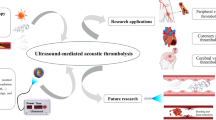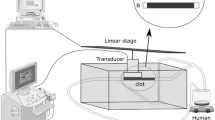Abstract
Ultrasound therapy has proven to be an efficient and safe modality for the treatment of acute arterial occlusions, and the use of therapeutic ultrasound for the treatment of thrombosis and vascular diseases holds great promise in overcoming the limitations of other available therapies. Still, there exists little published work that covers the different phenomena that take place in a thorough and comprehensive way. In this paper, we endeavor to address the subject by reviewing work on the physical properties of ultrasound propagation in the blood arteries as it relates to the cavitation of microbubbles, and we compare the impact of the different forces at work for clot disruption. Our conclusion is that the most important effect of ultrasound in the treatment of thrombotic disorders is the liquid-jet impact forces that result from strong bubble collapses in the vicinity of solid boundaries.
Similar content being viewed by others
References
Atar S, Luo H, Nagai T, Siegel RJ. Ultrasonic thrombolysis: Catheter-delivered and transcutaneous applications. European Journal of Ultrasound 1999;9:39–54.
Crum LA. Nucleation and stabilization of microbubbles in liquids. Appl Sci Res 1982;38:101–115.
Atchley AA, Crum LA. Acoustic cavitation in bubble dynamics in Ultrasound: Its chemical, physical, and biological effects. New York: K. S. Suslick, VCH Publishers, 1988:64.
Ivey JA, Gardner EA, Fowlkes JB, Rubin JM, Larson PL. Acoustic generation of intra-arterial contrast boluses. Ultrasound in Med {&} Biol 1995;21:757–767.
Maris H, Balibar S. Negative pressures and cavitation in liquid helium. Phys Today February 2000;29–34.
Szeri AJ, Storey BD, Pearson A, Blake JR. Heat and mass transfer during the violent collapse of nonspherical bubbles. Physics of Fluids 2003;15(9):2576–2586.
Branger AB, Eckmann DM. Experimental and theoretical intravascular gas embolism absorption dynamics. J Appl Physiol 1999;87:1287–1295.
Khismatullin DB, Nadim A. Radial oscillations of encapsulated microbubbles in viscoelastic liquids. Phys Fluids 2002;14:3534–3557.
Nyborg WL. Acoustic streaming. In: Hamilton MF, Blackstock DT, eds. Nonlinear acoustics. San Diego: Academic Press, 1998:207–232.
Ayme-Bellegarda EJ. Collapse and rebound of a gas-filled spherical bubble immersed in a diagnostic ultrasonic field. J Acoust Soc Am 1990;88:1054–1060.
Delius M. Medical applications and bioeffects of extracorporal shock waves. Shock Waves 1994;4:55–72.
Krasovitski B, Kimmel E. Gas bubble pulsation in a semiconfined space subjected to ultrasound. J Acoust Soc Am 2001;109:891–898.
Holland CK, Apfel RE. Thresholds for transient cavitation produced by pulsed ultrasound in controlled nuclei environment. J Acoust Soc Amer 1990;88:2059–2069.
Panza JA. High-normal blood pressure-more high than normal. New England Journal of Medicine 2001;345:1337–1340.
Apfel RE, Holland CK. Gauging the likelihood of cavitation from short-pulse-low-duty cycle diagnostic ultrasound. Ultrasound in Med {&} Biol 1991;17:179–185.
Holland CK, Apfel RE. Fundamentals of the Mechanical Index and caveats in its application. J Acoust Soc Am 1999;105:1324.
Harkin A, Nadim A, Kaper TJ. On acoustic cavitation of slightly subcritical bubbles. Physics Of Fluids 1999;11(2):274–287.
Crum LA (ed). Acoustic cavitation thresholds in water, in Cavitation and Inhomogeneities in Underwater Acoustics. Berlin, Springer Series in Electrophysics, W. Lauterborn; 1980;4:784–787.
Akhatov I, Lindau O, Topolnikov A, Mettin R, Vakhitova N, Lauterborn W. Collapse and rebound of a laser-induced cavitation bubble. Phys Fluids 2001;13(10):2805–2819.
Maisonhaute E, Prado C, White PC, Compton RG. Surface acoustic cavitation understood via nanosecond electrochemistry. Part III: shear stress in ultrasonic cleaning. Ultrasonics Sonochemistry 2002;9:297–303.
Devick-Kuhar B, Pfaffenberger S, Groeschl M, Kollmann C, Benes E, Gottsauner-Wolf M. In Vitro Thrombolysis enhanced by standing and travelling ultrasound wave fields. Ultrasound in Med {&} Biol 2002;28(9):1181–1187.
Leighton TG. The Acoustic Bubble. London, San Diego: Academic Press, 1994.
Zhang X, Inada T, Tezuka A. Ultrasonic-induced nucleation of ice in water containing air bubbles. Ultrasonics Sonochemistry 2003;10:71–76.
Torr GR. The acoustic radiation force. American Journal of Physics 1984;52:402–408.
Dayton PA, Klibanov A, Brandenburger G, Ferrara K. Acoustic radiation force in vivo: A mechanism to assist targeting of microbubbles. Ultrasound in Med. {&} Biol 1999;25:1195–1201.
Junge L, Ohl CD, Wolfrum B, Arora M, Ikink R. Cell detachment method using shock-wave–induced cavitation. Ultrasound in Med. {&} Biol 2003;29(12):1769–1776.
Schmidt-Nielsen K. Physiologie Animale. Adaptation et milieux de vie. Paris, Dunod edition, 1998.
Calas A, Perrin JF, Plas C, Vanneste P. Précis de physiologie. Paris, Doin edition, 1997.
Kodama T, Takayamay K, Uenoharaz H. A new technology for revascularization of cerebral embolism using liquid jet impact, Phys Med Biol 1997;42:2355–2367.
Kodama T, Takayama K. Dynamic Behavior Of Bubbles During Extracorporeal Shock-Wave Lithotripsy. Ultrasound in Med {&} Biol 1998;24(5):723–738.
Brennen CE. Cavitation and Bubbles Dynamics. Oxford University Press, 1995.
Williams PR, Williams PM, Brown SWJ. A study of liquid jets formed by bubble collapse under shock waves in elastic and Newtonian liquids. J Non-Newtonian Fluid Mech 1998;76:307–325.
Kodama T, Tatsuno M, Sugimoto S, Uenhora H, Yoshimoto T, Takayama K. Liquid jets, accelerated thrombolysis: A study for revascularization of cerebral embolism. Ultrasound in Med. {&} Biol 1999;25(6):977–983.
Kodama T, Uenohara H, Takayama K. Innovative technology for tissue disruption by explosive-induced shock waves. Ultrasound in Med. {&} Biol 1998;24(9):1459–1466.
Rosenschein U, Brosh D, Halkin A. Coronary ultrasound thrombolysis: From acute myocardial infarction to saphenous vein grafts and beyond current interventional cardiology. Reports 2001;3:5–9.
Carstensen EL, Gracewski S, Dalecki D. The search for cavitation in vivo. Ultrasound in Med {&} Biol 2000;26(9):1377–1385.
Dowsett DJ, Kenny P, Johnston R. The Physics of Diagnostic Imaging. London, ISBN 0 412 460602, London Arnold, 2001.
Tungjitkusolmun S, Tyler Satelin S, Haemmerich D, et al. Three-dimensional finite-element analyses for radio-frequency hepatic tumor ablation. IEEE Transactions On Biomedical Engineering 2002;49(1):3–9.
Wells P. Ultrasonic imaging of the human body. Rep Prog Phys 1999;62:671–722.
Author information
Authors and Affiliations
Rights and permissions
About this article
Cite this article
Hajri, Z., Boukadoum, M., Hamam, H. et al. An Investigation of the Physical Forces Leading to Thrombosis Disruption by Cavitation. J Thromb Thrombolysis 20, 27–32 (2005). https://doi.org/10.1007/s11239-005-2221-9
Issue Date:
DOI: https://doi.org/10.1007/s11239-005-2221-9




